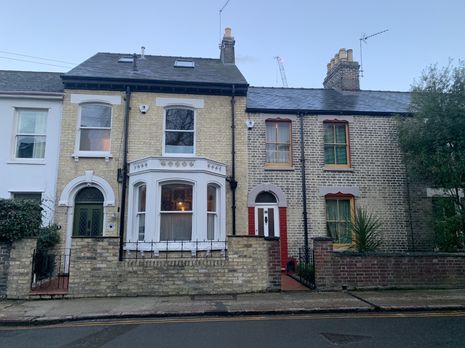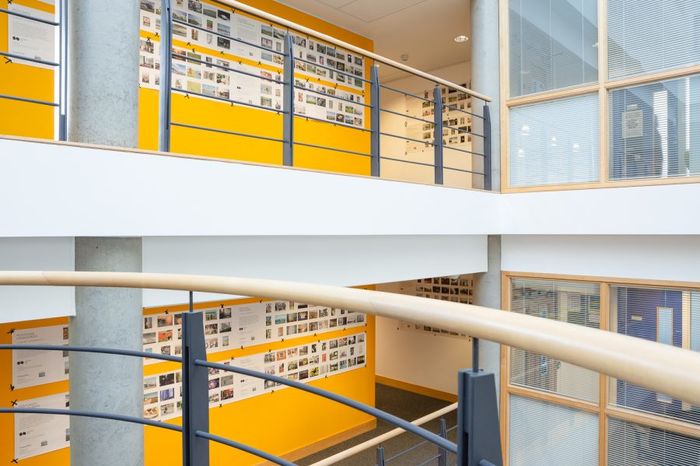David Parr House
Lily Davies reflects on her visit to the David Parr House and its celebration of the Arts and Crafts movement

‘Have nothing in your house that you do not know to be useful, or believe to be beautiful.’ So said William Morris. The David Parr House tucked away on Gwydir Street, just off Mill Road (billed as the antidote to the sometimes intense atmosphere of central Cambridge), is both. Inside this unassuming terrace is a beautiful time capsule celebrating the Arts and Crafts movement, all hand painted by the working-class artworkman David Parr over the many years that this place was his home, while he worked for the Leach Firm. It is an ode to the intricate, recurring patterns of William Morris’ style, whom the Leach Company sometimes worked for on various other, grander buildings around Cambridge, such as Jesus College Chapel and Queens’ Hall, as well as the ceiling of St Michael’s Church.
“It’s an important break from the vast, sometimes austere and inaccessible spaces of museums”
Several conversations with various friends have revealed that this heritage venue exists largely outside the consciousness of most (based on my admittedly small sample size!) students at the university. I only became aware of it back in the depths of Michaelmas, when my Aunty Jo-Jo messaged after seeing it on TV. So, after the house had reopened from their Christmas break, I rang the doorbell to join the five other people on the tour. We were brought from the visitor centre next door into the home itself, and into the front room, the most ornately decorated. I had initially thought the walls were decorated with wallpaper, until a closer inspection revealed tiny black pouncing marks, where the design was transferred onto the walls to provide an outline. When the house was preserved, the painter, Saskia Huning, recreated these techniques, mimicking David’s style and observing the particular way the tips of his leaves carried a ‘distinctive flick’. The YouTube video explaining her process is fascinating and a completely therapeutic watch! It is incredible to think about the way the walls would have glowed under candlelight, with the covering layer of varnish.
The house offers an indication of David’s aspiration for his family, installing and mimicking some of the mod-cons more recognizable in stately homes. When I spoke to the curator, Charlotte, she explained how it was also a celebration of the ‘makers and the creators, rather than the patrons’. It’s an important break from the vast, sometimes austere and inaccessible spaces of museums, instead telling a different story. In this way, it echoes the ethos of the Arts and Crafts movement, which was opposed to industrialization and favoured a return to nature. A quote from As You Like It, which reads, ‘Tongues in trees, books in the running brooks, Sermons in stones and good in everything’, tracks the walls of the front room, which illustrates this recall to harmony. I wonder whether Mary, David’s wife, felt the same as she brought up their children while David pottered around from room to room, not necessarily finishing a project before he started the next.
But the house also tells the dual story of Elsie, David’s granddaughter, who lived in the house for 85 years before the trust acquired it, offering another important dimension: a space where real people talked, washed, ate, contemplated, and laughed. Charlotte has described Elsie as ‘the first curator’, in a way, of the house, preserving her grandfather’s designs. Throughout the conservation process, it was specifically stressed that minimal and non-invasive alterations were needed (washing surfaces with just water and one drop of washing up liquid) to maintain the very personal and familial story within the ‘cared-for interior’. It is quite emotional to see Elsie’s belongings still there, as if she was merely in the next room. Through them, we can view her quirks: attaching the curtains round the rails with her brooches instead of sewing them, the fact that her Radio Times was contained within an embroidered cover (something my granddad does but with wrapping-papered cardboard, but which I didn’t realise was characteristic of the older generations), and a neighbour’s recollection of Elsie’s remedy for feeling a bit unwell, which was to drink the water an onion had boiled in. There was also a patchwork quilt, family photos, tins in her cupboards, each a little clue to a life.
During the pandemic, the house was forced, like many other venues, to take a more ‘pragmatic, creative approach’ to proceedings, having only been opened for one full season. Therefore, the house went digital, creating an online tour exploring each of the objects in depth and their significance within the space, making it generally more accessible. Their entire virtual space is a really interesting resource which collates lots of stories from neighbours, information about the local area, and the conservation process. It’s an ongoing project, with lots of hopeful avenues of exploration from archive material yet to be explored.
The personality of the house, with its amalgamation of previous residents, is a place in which to reflect on our own ordinary and extraordinary stories, and will long remain a joyful way to pass an afternoon.
Tours of the house are restricted to 6 visitors per tour and can only be booked in advance via the website – www.davidparrhouse.org/visit. To book a personal guided virtual tour, please visit - https://davidparrhouse.org/product/online-tour/
 Comment / Plastic pubs: the problem with Cambridge alehouses 5 January 2026
Comment / Plastic pubs: the problem with Cambridge alehouses 5 January 2026 News / Cambridge businesses concerned infrastructure delays will hurt growth5 January 2026
News / Cambridge businesses concerned infrastructure delays will hurt growth5 January 2026 News / New movement ‘Cambridge is Chopped’ launched to fight against hate crime7 January 2026
News / New movement ‘Cambridge is Chopped’ launched to fight against hate crime7 January 2026 News / AstraZeneca sues for £32 million over faulty construction at Cambridge Campus31 December 2025
News / AstraZeneca sues for £32 million over faulty construction at Cambridge Campus31 December 2025 Interviews / You don’t need to peak at Cambridge, says Robin Harding31 December 2025
Interviews / You don’t need to peak at Cambridge, says Robin Harding31 December 2025










